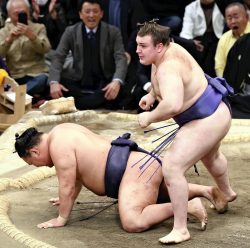Olympics Bet Against Climate Change with Seine Swimming. For days, It Looked like They would Lose

A man wipes his face as he walks past reproductions of artworks decorating the banks of the River Seineat the 2024 Summer Olympics, Tuesday, July 30, 2024, in Paris, France.
14:28 JST, July 31, 2024
With plans for athletes to swim the Seine River through the heart of Paris, Olympic organizers essentially bet against climate change’s extreme weather. For several days it appeared they would lose — by ditching the swimming portion of triathlon races.
It wasn’t until early Wednesday, after the men’s race had been postponed a day and test events called off, that organizers announced the most recent tests showed the water met standards to allow swimming.
Some scientists and engineers said organizers were taking a huge gamble at a time when heavy rains have increased with human-caused climate change, especially in Europe. The rains run off from the urban environment and contribute to higher bacteria levels in the city’s famed river.
“They just gambled, flipped the coin and hope for a dry season and it turned out to be the rainiest in the last 30 years,” said Metin Duran, a professor of civil and environmental engineering at Villanova University who has researched stormwater management.
Organizers “had worked through most of the scenarios related to computer hacking and physical threats without fully assessing the implications of extreme events associated with climate,” said University of Arizona climate scientist Kathy Jacobs, who directs the Center for Climate Adaptation Science and Solutions. “It’s definitely time to take climate threats seriously.”
If any city could be expected to be mindful of the challenges of climate change, it’s Paris. It’s where the most significant climate agreement in history was struck almost a decade ago — to try to limit Earth’s warming to 1.5 degrees Celsius (2.7 degrees Fahrenheit) above pre-industrial levels. And the Paris games aspire to have half the carbon footprint of earlier games held in London and Rio de Janeiro.
Paris, like many older cities around the world, has a combined sewer system, which means that the city’s wastewater and stormwater flow through the same pipes. With heavy or prolonged periods of rain, the pipes’ capacity is reached, sending raw wastewater into the river instead of a treatment plant.
Paris spent 1.4 billion euros ($1.5 billion) to improve the water quality in the Seine, including building a giant basin to capture excess rainwater and keep wastewater from entering the river, renovating sewer infrastructure and upgrading wastewater treatment plants.
But persistent rains, which dampened the opening ceremonies and temporarily gave way to a heat warning on Tuesday, worked against that. Tuesday’s men’s triathlon was postponed to Wednesday. The city has had at least 80 rainy days in Paris so far this year, about two-and-a-half weeks more than normal, according to the French meteorological office.
An AP analysis of weather data found that Paris in 2024 had its second-highest number of rainy days since 1950, surpassed only by 2016. There’s been only one weeklong dry spell this year to give the drainage system a break. Normally there’s at least three by this time, the AP analysis shows.
“Heavy rainfall in the summer has always been a possibility and with a warming climate these heavy rainfall events have only become heavier, said Friederike Otto, a climate scientist at the Imperial College of London. ”Thus, that definitely would need to have gone into the planning.”
A study last week in the journal Science found a noticeable global increase in the variability — the all-or-nothing quality — of rain and snow in the past 100 years with a big jump starting in 1960. Researchers then did the standard climate attribution analysis to compare what actually happened with what would have been expected in a fictional world without human-caused climate change. They found this increase in heavy rains punctuated by longer dry spells had global warming’s fingerprints on it.
The study also found three areas — Europe, eastern North America and Australia — had seen much higher jumps in the increase in rainfall extremes.
The laws of physics dictate that warmer air holds more moisture, which comes down as heavier rain, while climate change then changes weather patterns, making them more stuck in downpours or sunny days without clouds, said study co-author Peili Wu, a climate scientist at the United Kingdom Meteorological Office.
Organizers said what happened was beyond their control. Aurélie Merle, the Paris 2024 director of sports, noted to reporters Tuesday that previous triathlon competitions had sometimes been pared back to duathlons. That was before the early Wednesday announcement that swimming in the Seine would move forward.
Duran, the Villanova professor, noted that the acceptable pollution level for the triathlon is nearly four times weaker than the U.S. Environmental Protection Agency has for swimmable waterways. Paris’ mayor made a public show of swimming in the river earlier this month, something Duran called a publicity stunt. He said he would not swim in the Seine.
He called the underground storage basins “the last thing any stormwater expert would suggest as a solution,” Duran said. Few cities use that solution any more because it’s limited and easily gets overwhelmed by the heavier and more frequent rains of climate change. It’s a solution for the era before global warming kicked in heavily, he said.
Future Olympics sites need to take a wetter world into consideration, Villanova’s Duran said: “The sewer overflow issue is bound to get worse until climate change is addressed.”
Los Angeles, the host city for the 2028 games, could learn a lesson and work toward more green spaces and fewer private vehicles, Imperial College’s Otto said.
“Olympic games are a great opportunity to change cities as for some reason people accept that athletes need to have a healthy environment whereas ordinary citizens should live within pollution, traffic, noise and risk their life and health,” Otto said.
"Sports" POPULAR ARTICLE
-

Aonishiki Caps Chaos in Kyushu Grand Sumo Tournament with Playoff Win over Hoshoryu
-

Speed Skater Yukino Yoshida Clinches Ticket to Milan
-

Yoshinobu Yamamoto Cheered by Los Angeles Lakers Fans at NBA Game
-

Kenta Maeda Joins Rakuten Eagles; Returns from American MLB to Japanese Pro Baseball for First Time Since 2015
-

Ukrainian Sumo Wrestler Sekiwake Aonishiki to be Promoted to Ozeki
JN ACCESS RANKING
-

Keidanren Chairman Yoshinobu Tsutsui Visits Kashiwazaki-Kariwa Nuclear Power Plant; Inspects New Emergency Safety System
-

Imports of Rare Earths from China Facing Delays, May Be Caused by Deterioration of Japan-China Relations
-

University of Tokyo Professor Discusses Japanese Economic Security in Interview Ahead of Forum
-

Japan Pulls out of Vietnam Nuclear Project, Complicating Hanoi’s Power Plans
-

Govt Aims to Expand NISA Program Lineup, Abolish Age Restriction























